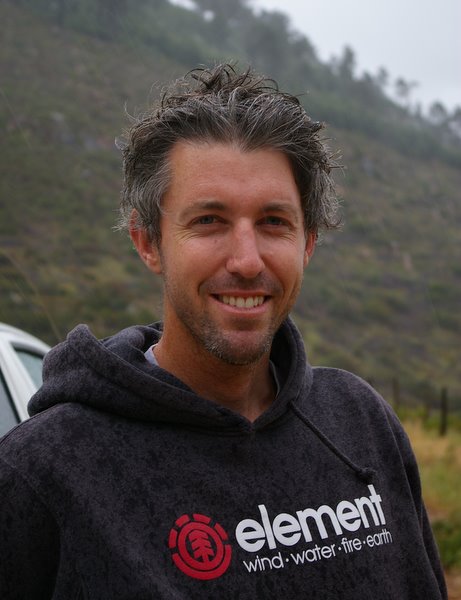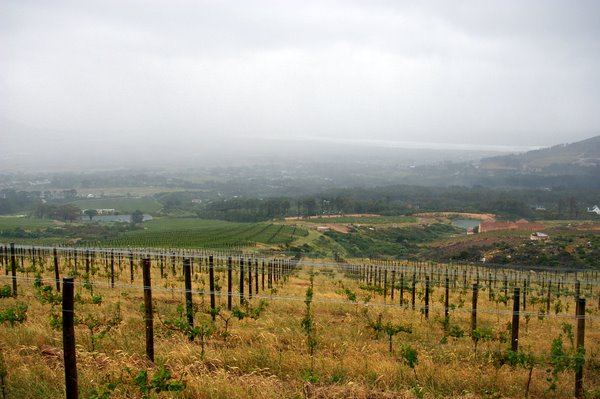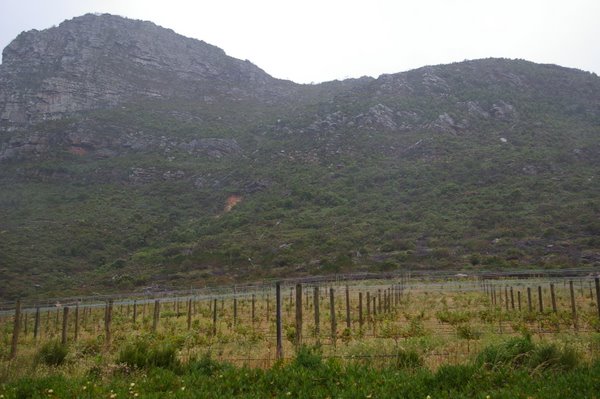|
Cape
Point Vineyards
One of South Africa's rising stars

Duncan
Savage (above) is the dude in charge of Cape Point, one of
South Africa’s most exciting wineries. He’s been in the hot seat
for seven vintages now, even though this still seems like quite a
new project. The first vines were actually planted in 1996, then
some more was added in 2000, and a further recent planting means
that there are now 10 ha of young vines.
Duncan
encapsulates all that is good about the new face of the South
African wine industry. He’s willing to experiment; he has an open
mind; he has a vision for where he would like to go; and where he
wants to go is a good destination—that is, he has a really good
handle on the difference between ordinary wine and truly interesting
wine.

Cape
Point has two properties, with 33 hectares in all. The focus is
strongly in favour of white wines (24 hectares of white varieties as
opposed to 9 hectares of red). The main vineyard is overlooking the
sea at Cape Point, but frustratingly it was raining hard when we
visited, so we didn’t get the spectacular view down to the sea
that is normally gained from a hike up to the top of the property.
Duncan
cites Rosa Kruger, viticulturalist at Antonij Rupert, as a big
influence: he spent a year working with her, and she’s helped him
out with his work at Cape Point.
Sauvignon
Blanc is the main emphasis at Cape Point, and I asked Duncan about
whether there’s a shift in style away from those Sauvignons that
had the strong green pepper/herbal character that comes from a group
of compounds called methoxypyrazines. ‘The South African market
has favoured the pyrazine character,’ agrees Dunacn. ‘Over the
last couple of years there has been a trend to less one-dimensional
wines. In the past they were showing too much methoxypyrazine.’
‘When
we started out our wines were unique,’ says Duncan. ‘We were the
only farm in the area and our wines were different. Now we see a lot
of maritime Sauvignons.’ It’s perhaps for this reason that
Duncan has decided to begin playing with the Cape Point house style
a bit. ‘We have built our brand as a style that is herbaceous in
youth, but which develops,’ he says. ‘Now we are on a different
track: we want to make Sauvignon that is different. There’s a lot
of reductively made Sauvignon around. I want to do something
different.’ This could be bad news for the competition. Cape Point’s
Sauvignons are already very highly regarded. If they get better,
then others will find it hard to keep up.

‘Now
we want to look for riper, more voluptuous flavours: citrus and
grapefruit characters, and stone fruits,’ explains Dunacan. ‘We’re
looking for more textured wines; something with more citrus
character and something that will develop in bottle.’ As part of
this quest for style evolution, from 2010 the basic Sauvignon Blanc
will be 80% barrel fermented in 600 litre barrels.
Duncan
adds that, ‘Methoxypyrazine flavours are like concrete in a wine:
if you oxidise your thiols, this leaves them exposed. Malolactic
fermentation can do this. I don’t do malolactic with any
Sauvignon: I did an experiment and it went down the drain.’
For a
few years now Cape Point have made an really nice varietal Semillon,
but 2008 will be the last vintage of this wine. ‘I think Semillon
is great, but more from a blending point of view,’ Duncan
explains. But Semillon remains an important variety for Cape point,
because it is used in blending Eilidh (the top Sauvignon), and a new
vineyard of Semillon will be planted with the vines trained on
single stakes at a density of 8500 vines/hectare. The advantage of
staked vines is that you take out the row effect, and the sun can
reach the grapes from any angle, without leaves shading fruit.
Duncan
is very interested in experimenting with his cellar work. ‘Surely
there is more to winemaking than stainless steel and oak.’ Duncan
has been interested in using amphorae, but didn’t want to import
them. He contacted a local potter, Yogi de Beer, who is throwing 600
litre pots for Duncan. He describes this experimentation as a ‘cool
journey’. The first pots he tried were 120 litres (the potter he
used only had a small kiln). When Duncan poured wine in they leaked
like sieves (they were earthenware and had only been fired at low
temperatures).
The
ones he’s using now are stoneware clay made with high firing
temperatures. They aren’t lined. Duncan currently has capacity for
3000 litres. He’s trying reds, and has done a long maceration of
Grenache that has been allowed three months on skins.
He’s
really enthusiastic about the future for South African wine. ‘For
me, South Africa is “watch this space”. The potential is huge.’
THE
WINES
Cape
Point Sauvignon Blanc 2008 WO Cape Point
From sandstone-derived soils with a bit of decomposed granite,
as well as clay and quartz. 7% Semillon in the blend, with a bit in
oak. Crisp and focused with lovely herb and pepper notes, and nice
texture. Grassy and intense, this shows minerality and focus with
some rounded texture and great balance. 91/100
Cape
Point Isliedh 2008
22% Semillon, from a special high-up part of the vineyard, aged
in 600 litre barrels, one-third new; the balance is Sauvignon Blanc.
Taut mineral and grapefruit nose with lovely precision and a floral
hint. The palate is concentrated and pure with lovely precision and
nice minerality. Rounded stone fruits and good texture. Thrilling.
93/100
Cape
Point 2008 Chardonnay
Barrel fermented in 600 litre barrels, 40% new. Bright, fruity,
pure and focused with bright lemon and citrus fruit. Nice precision
and some nutty hints. Hardly any oak influence, other than adding
texture. Complex, pure and nutty with lovely complexity and purity.
Very serious. 93/100
Cape
Point 2005 Semillon
Barrel fermented in old oak. Very distinctive melange of chalky,
herby methoxypyrazine characters with intense lemony fruit. Very
pure: crystalline and minerally with some grapefruit notes. Precise
with lovely freshness. Thought provoking. 91/100
Scarborough
Red 2007
A relatively inexpensive (45 Rand) Cabernet/Shiraz blend. Fresh
cherry/berry fruit nose with a chalky edge. Lovely bright cherry
fruit on the palate with nice purity and focus. Enjoyable and fruity
– Duncan says that he is not trying to force young vines into
something that they are not. 87/100
SOUTH
AFRICA REVISITED
 Part
1, Tulbagh Mountain
Vineyards Part
1, Tulbagh Mountain
Vineyards
 Part 2, Cape
Point Vineyards Part 2, Cape
Point Vineyards
 Part 3, AA
Badenhorst Family Wines Part 3, AA
Badenhorst Family Wines
 Part 4, Eben
Sadie: Sadie Family Wines and Sequillo Cellars Part 4, Eben
Sadie: Sadie Family Wines and Sequillo Cellars
 Part 5, Paul
Kretzel of Lammershoek Part 5, Paul
Kretzel of Lammershoek
 Part 6, Mullineux
Family Wines Part 6, Mullineux
Family Wines
 Part 7, Vondeling Part 7, Vondeling
 Part 8, Scali Part 8, Scali
 Part 9, Sterhuis Part 9, Sterhuis
See
also:
 Visiting
South Africa's wine lands (a series based on a trip in December
2005) Visiting
South Africa's wine lands (a series based on a trip in December
2005)
Wines
tasted 11/09
Find these wines with wine-searcher.com
Back
to top
|

